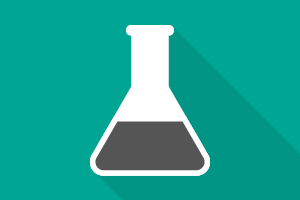Classroom Resources: Chemistry Basics
Filter by:
1 – 25 of 51 Classroom Resources
-

Electromagnetic Spectrum, Observations, Scientific Method, Experimental Design, Error Analysis, Accuracy, Chemical Properties | High School
Lesson Plan: Screen Your Sunscreen! Mark as Favorite (4 Favorites)
In this lesson, students will learn more about UV radiation, its effect on skin, and the different ways in which sunscreen protects skin. After exploring this, students will develop an investigation to assess the claims made by different sun protection products. Students will compare the effectiveness of a variety of sunscreens and/or clothing that claim to offer sun protection. The lab will be wrapped up with a CER-style report.
-

Identifying an Unknown, Experimental Design, Scientific Method, Chemical Change, Net Ionic Equation, Precipitate, Solubility, Solubility Rules, Balancing Equations, Predicting Products, Chemical Change | High School
Lab: Mislabeled Mess! Mark as Favorite (28 Favorites)
In this lab, students will identify 3 unknown acids by using the solubility rules. They will be given a list of materials and will design their own procedures for identifying the unknowns. For each combination of reactants, they will predict whether a product forms and, if it does, write complete and net ionic equations for those reactions.
-

Scientific Method, Experimental Design, Observations, Introduction, Graphing | Middle School, High School
Lab: Applying the Scientific Method to Stain Removal Mark as Favorite (57 Favorites)
In this lab, students will explore the real scientific process by designing an experiment to solve a problem. Students will learn about basic lab equipment, safety, and the scientific process of trial and error while solving a common problem: What color of food coloring requires the most bleach to remove?
-

Experimental Design, Scientific Method, Graphing, Observations | Middle School, High School
Lab: Mentos and Soda Investigations Mark as Favorite (21 Favorites)
In this lab, students will design their own experiment in which they manipulate a variable that relates to Mentos and soda. Students will generate a testable question, design an experiment, collect and analyze the data and present their findings.
-

Scientific Method, Observations, Experimental Design, Physical Properties | Elementary School
Lab: Stains, Stains, Go Away Mark as Favorite (6 Favorites)
In this lab, students will become more familiar with the scientific method as they investigate what type of cleaning product is best. Students will identify variables as they carry out a controlled test to compare the ability of different products to remove a ketchup stain.
-

Scientific Method, Observations, Experimental Design | Elementary School, Middle School
Lab: Introducing the Scientific Method Mark as Favorite (19 Favorites)
In this lab, students will be introduced to and become familiar with the scientific method. They will apply their understanding by following the steps of the scientific method while investigating the amount of fat in potato chips.
-

Experimental Design, Scientific Method | Middle School, High School
Activity: Designing a Procedure for Product Testing Mark as Favorite (11 Favorites)
In this activity, students will take on the role of research engineers who work for a chemical company that sells coatings for different types of surfaces. Students are required to design a procedure for testing their common household coating to prove its durability to various types of stresses. Students will be required to create procedures that can collect both quantitative and qualitative data as well as an appropriate data table.
-

Chemical Change, Scientific Method, Experimental Design, Observations, Inferences | Middle School, High School
Demonstration: What Causes Yeast to Ferment? Mark as Favorite (3 Favorites)
In this lesson, students will observe and verify molasses sugar content as a result of its ability to ferment yeast. They will compare how molasses allows yeast to ferment with other sugar solutions as well as a sugar-free solution.
-

Graphing, Scientific Method, Experimental Design | Elementary School, Middle School
Activity: Graphing Glow-in-the-Dark Paint Mark as Favorite (18 Favorites)
In this activity, students will have the opportunity to review the scientific method, and analyze data from a scenario about glow-in-the-dark paint. Additionally, students with create a graph to help them to interpret data.
-

Scientific Method, Observations | Middle School
Lab: Which Paint is the most Cost-Effective Mark as Favorite (1 Favorite)
In this lab, students will practice implementing the scientific method in order compare the properties of different paint samples through a variety of testing. Students will research consumer reports, hypothesize, and conduct specific tests in order to determine which brand of paint is the most cost effective.
-

Polymers, Physical Properties, Chemical Properties, Physical Change, Chemical Change, Observations, Scientific Method, Mixtures | Middle School
Lesson Plan: Exploring the Chemistry of Oil and Acrylic Paints Mark as Favorite (13 Favorites)
In this lesson students learn about the chemistry of oil and acrylic paints. They make their own paint, and complete an experiment to collect qualitative and quantitative data through a series of tests. Students will also apply the concepts of physical and chemical change to the results of this controlled experiment.
-

Scientific Method, Observations, Inferences, Intermolecular Forces, Mixtures | High School
Lab: Magic Milk Mark as Favorite (48 Favorites)
In this lab, students will investigate the addition of detergent to a mixture of whole milk and food coloring. Students will attempt to explain the cause of their observations. Also, students will have the opportunity to manipulate the experiment and determine how other variables may impact the results.
-

Scientific Method, Observations | High School
Lesson Plan: Is it Real Science or Pseudoscience? Mark as Favorite (18 Favorites)
In this lesson, students will deepen their knowledge of the scientific method by learning how to determine if researched information is valid and if it should be used for gaining or furthering our scientific knowledge. Students will view the documentary “Mermaids: The Body Found”, a pseudo-documentary that was later reported to be a hoax by the Discovery Channel. They will then use a “Baloney Detection Kit” to analyze the authenticity of information presented through different media as scientific fact.
-

Concentration, Mixtures, Interdisciplinary, Scientific Method, Measurements | Middle School, High School
Lab: Effect of Salt Concentration on Plants Mark as Favorite (9 Favorites)
In this lab, students will observe how salt concentration can affect the structure of a potato tuber.
-

Chemical Change, Physical Change, Chemical Change, Scientific Method, Melting Point, Phase Changes | Middle School
Lab: S'more Change Please Mark as Favorite (10 Favorites)
In this lab, students will be able to demonstrate the difference between a physical and chemical change by making ooey, gooey, yet yummy S’mores!
-

Physical Properties, Observations, Experimental Design, Scientific Method | High School
Lesson Plan: Not Breaking Up is Hard to Do: the Properties of Glass Mark as Favorite (18 Favorites)
In this lesson students will learn about the properties of glass, and relate those properties to the new engineering design of glass in a car.
-

Limiting Reactant, Stoichiometry, Dimensional Analysis, Mole Concept, Scientific Method | High School
Lab: Limiting Reactants in Brownies Mark as Favorite (23 Favorites)
In this lesson, students will investigate the idea of limiting reactant using a brownie recipe.
-

Introduction, Interdisciplinary, Scientific Method | High School
Activity: Write the Methods Section Mark as Favorite (6 Favorites)
In this activity, students will learn how to write and think like a scientist when they complete their lab write ups.
-

Polarity, Polymers, Molecular Structure, Monomer, Intermolecular Forces, Scientific Method, Chemical Change, Intermolecular Forces | Middle School
Lesson Plan: Watch the Baby! Superabsorbent Polymer Mark as Favorite (5 Favorites)
In this lesson, students will learn about how polymers, specifically superabsorbent polymers, work. Through lab activities, students will investigate polymer properties.
-

Density, Measurements, Graphing, Experimental Design, Scientific Method, Physical Properties, Error Analysis, Significant Figures, Error Analysis | High School
Lab: Investigating the Density of an Irregular Solid Object Mark as Favorite (36 Favorites)
In this lab, students will use common laboratory equipment to devise a method to measure the density of several irregular objects. They will then create a formal laboratory report using both their own data and data from the entire class.
-

Physical Properties, Intermolecular Forces, Identifying an Unknown, Experimental Design, Scientific Method, Error Analysis, Graphing, Molecular Structure | High School
Lesson Plan: The Importance of Motor Oil Viscosity in Optimal Car Functioning Mark as Favorite (14 Favorites)
In this lesson students will determine how temperature affects viscosity and relate the data to the structure of motor oil and the optimal functioning of a car.
-

Molecular Structure, Interdisciplinary, Scientific Method | Middle School
Lesson Plan: The Effect of Different Foods on Mealworms Mark as Favorite (1 Favorite)
In this lesson, students will look at the chemistry of the molecules of carbohydrates, fats, and lipids, and they will use this information to determine a diet for their mealworm and will collect information about the mealworm to test a hypothesis.
-

Identifying an Unknown, Culminating Project, Classification of Reactions, Experimental Design, Scientific Method, Interdisciplinary, Review, Balancing Equations, Stoichiometry, Concentration, Molarity | High School
Lab: The Culminating Unknown Mark as Favorite (34 Favorites)
In this lab, students identify an unknown from a list of 12 possible compounds by designing a procedure and using evidence to prove their claim. They must draw from knowledge gained throughout the year to properly develop a procedure to identify the unknown.
-

Phase Changes, Physical Properties, Melting Point, Observations, Scientific Method | Elementary School
Lab: Ice Cube Race Mark as Favorite (1 Favorite)
In this lab, students will investigate what factors can influence the change in state of matter from a solid to a liquid. They will have the opportunity to make a hypothesis and participate in the design and completion of an experiment.
-

Chemical Change, Physical Change, Separating Mixtures, Observations, Mixtures, Chemical Properties, Physical Properties, Experimental Design, Scientific Method | High School, Middle School
Lab: Test Tube Separation Mark as Favorite (23 Favorites)
In this lab, students will mix four substances in a test tube and recreate the original four layers through chemical and physical means.